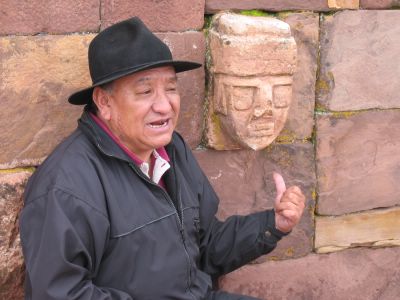The Tiwanaku Ruins, Bolivia (February, 2004)

I'm happy to be traveling again, and intrigued as ever by many of the sites I'm seeing.
Was it simply natural for ancient civilizations to build pyramids and orient them according to the alignments of heavenly bodies (including the sun's movements)? Or was there pre-Columbus trans-Atlantic influence as Ivan Van Sertima asserts in his book, They Came Before Columbus? I'm inclined to believe the latter. Thor Heyerdahl proved it was possible to cross the Atlantic in a reed ship, and interestingly enough reed boats similar to those used in Egypt eons ago are still being made and used here on Lake Titicaca. It's mind blowing!

Reed Boat, Lake Titicaca, Bolivia

Tiwanaku is the name of the site of ruins found near La Paz which was built by the Aymara people who are believed to be the predecessors of the Incas. Built on the shores of Lake Titicaca, it is considered by many to be the cradle of civilization in South America.

Youth International, Tiwanaku, Bolivia

I remember being amazed by the pyramids built by the Mayans in Honduras when I was traveling there 4 years ago, and being intrigued by what looked liked a lion's head in the glyphs etched into the monuments there in Copan. Now, after visiting the museum at Tiwanaku I learned from their timeline that Egyptian pyramids were built around 5,000 BC. The pyramids in Mesopotamia went up around 3,000 BC. The Olmec heads – massive stone sculptures of heads with African features - appeared in Central America around 1,000 BC.

9' X 18' Olmec Head, Mexico


12' X 22' Olmec Head, Mexico

The Tiwanaku pyramids were being built around 200 AD. Some might call it coincidence, but I think brothers were sailing the Atlantic long before Columbus was born. Something else to think about: The llama was created by the Aymara by breeding the indigenous alpaca with CAMELS! There are no camels here now, but skeletons of camels have been found near the ruins and are on display at the museums here. They're not indigenous to the region. They simply appeared shortly before the Tiwanaku complex came into existence! Makes you think, huh?
Our guide also believes the Aymara were influenced by other races that arrived in South America long before Columbus. In fact, there is a plaza which is decorated with sculptures of heads which represent the diversity of races the Aymara knew. My guide suggested I take a photo next to the one which is supposed to represent Africans (It’s not as detailed or refined as it would have been 1800 years ago, but you can still make out the broad lips and nose.). He took one next to the face representing his ancestors.

Multicultural Plaza, Tiwanaku, Bolivia


African Face, Tiwanaku, Bolivia


Our Tiwanaku Guide, Carlos & Aymara Face

OK, enough of the history lesson, just trying to share a few more things from our trip. It's summer time in the southern hemisphere, but at 13,000 feet, La Paz is pretty cold. My host mom thinks I'm cold because I don't eat enough and my clothes aren't made of wool. Never mind the fact that I eat more than everyone else at the table, and that I have on 5 layers including 2 fleeces and my snowboarding jacket. I'm having a hard time convincing her that I'm a summer baby from Charleston, South Carolina who's cold because the heat is not on in an un-insulated house where the temperature is 45 degrees!
The house is cold, but the people are warm. My host mom is a lovely woman, who is hooking us up with "rico" Bolivian dishes including llama steaks and quinua soup. I am truly enjoying myself, but I am looking forward to heading down to sea level and the warmer weather of Cochabamba and Rurrenabaque.
The Valley of the Moon is just outside of La Paz. With its awe inspiring silt pinnacles and gullies juxtaposed against the bright red of the copper mountain in the background reminded me that God is an artist (despite the fact that my crappy disposable camera couldn’t do the landscape justice).

Valle de la Luna, Bolivia

Coca tea, plenty of water and rest have helped me get over my altitude sickness. I'm still breathing a little harder than I think I should be when I walk up some of these hills, but I'm well enough that I actually played soccer yesterday. My team lost the first game, but we were short a player so it was OK. We won the second game, and I actually scored a couple of goals in each game. I wasn't as sure footed playing in my hi-tech Adidas aqua-socks as I am in my cleats, but I'm working with what I have. :) Have to admit that I have never felt so out of shape in my life, but since the 19 & 20 year olds in my group were doubled over sucking air too, I realize that it had much more to do with the altitude than anything else.
Interesting tidbit on soccer: My Spanish professor says it started on this side of the world when Aztecs would kick around the heads of those they sacrificed to see which team would be responsible for finding the next group of men to be sacrificed in case the gods weren't happy with the sacrifice they just offered.
Alright, I'll end this here before I start to bore you with more history. We're off to Salar de Uyuni and the carnival in Oruro at the end of the week. The update thereafter should be a little more interesting.


1 Comments:
Awsome pictures, please take more pics and more close-ups and the whole landscape. Please tell us more on the history, this is very very interesting. I just finished reading Chariots of the Gods and it mentions these ruins.
Post a Comment
<< Home